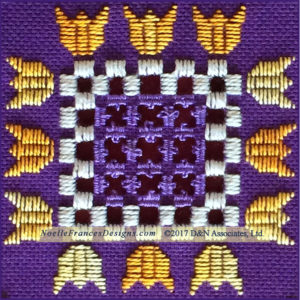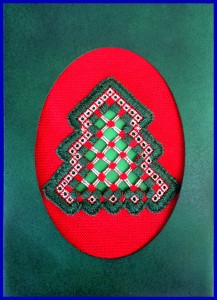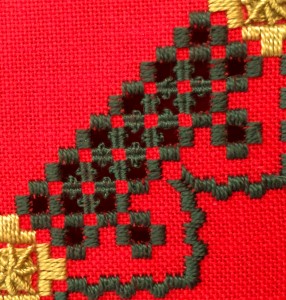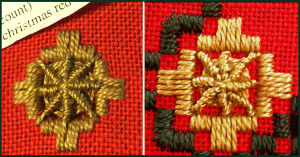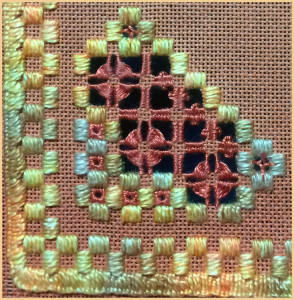| The Hardanger Satin Stitch: The hardanger satin stitch is the basic, the foundation stitch for hardanger embroidery. The hardanger stitch is different from a surface or embroidery satin stitch, but they are similar in that the stitching threads do not cross over each other and you do not pierce the thread of any previous stitches. A surface embroidered satin stitch is often padded and the outline stitch is used to give height to the edge, and the tip of the needle may pierce the fabric thread as you bring the stitching thread through.The hardanger satin stitch is single layer (not padded); the tip of the needle always comes up in a fabric hole, the needle never pierces the fabric thread or a stitching thread. Also the start and end tails of the stitching thread are secured by weaving through existing worked area. To see this click here to view my blog page discussion No Knots Please! |
|
Hardanger satin stitches are used to create kloster blocks and for use within geometric-shape patterns. Notice how alike the back looks to the front on the hardanger flower shape and kloster blocks shown in this photo. |
| Kloster blocks: Hardanger satin stitches are the foundation building block to create kloster blocks. Click here to view my kloster block discussion and cutwork (openwork).
Below photos are examples of non-openwork and openwork kloster blocks.
|
|
Cutwork: |
– In order to incorporate cutwork into a two-sided kloster area each side is perpendicular to its neighbor, must share a common corner fabric hole with its adjoining perpendicular side and have a mirror-image two-sided kloster block opposite it.
– For three-sided kloster block area you need three sides with the middle side perpendicular to its neighboring sides and sharing a common corner fabric hole with the adjoining sides. Plus a three-sided kloster block when used within cutwork needs a mirror-image three-sided kloster block opposite it.
– For four-sided kloster blocks, each side is perpendicular to its neighboring sides, must share a common corner fabric hole with its adjoining perpendicular sides and have a mirror-image opposite side.
|
Bar Weaving: The three styles of of bar weaving I have used are: wrapped bars, buttonhole worked bars and figure-8 looped bars. |
Fill-in Stitches that I discuss are shown as hyperlinks below:
| When I am working an area of bar weaving and/or fill-in stitches I like to set back a moment and determine a stitching pathway. Click here to view my blog page discussion of pathways. |



